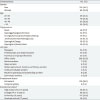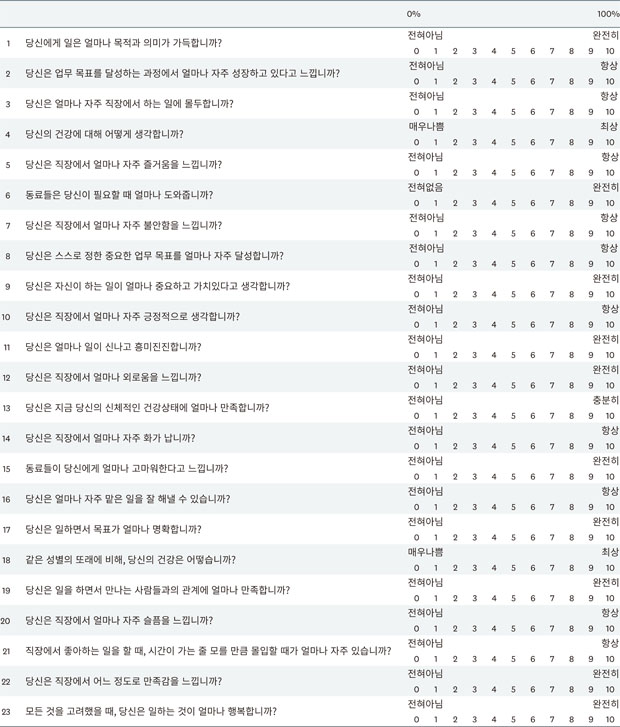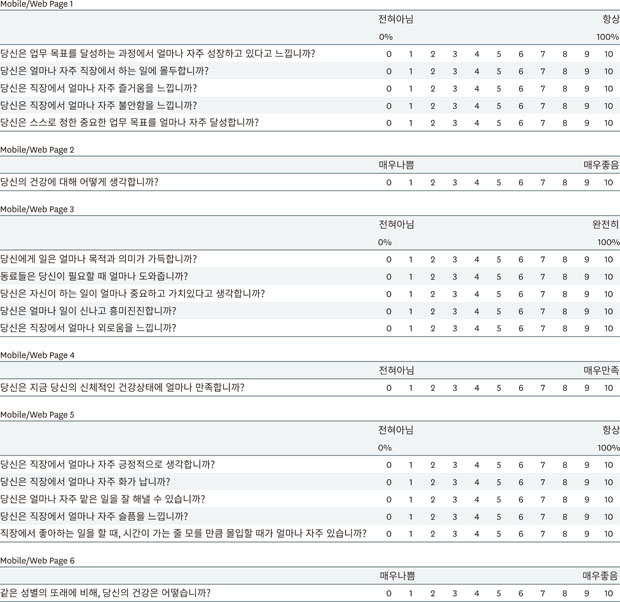1. Maggino F. Assessing the subjective wellbeing of nations. In : Glatzer W, Camfield L, Møller V, Rojas M, editors. Global handbook of quality of life. New York: Springer;2015. p. 803–822.
2. Diener E, Chan MY. Happy people live longer: subjective well-being contributes to health and longevity. Appl Psychol Health Well Being. 2011; 3(1):1–43.

3. Hassan E, Austin C, Celia C, Disley E, Hunt P, Marjanovic S, Shehabi A, van Dijk LV, van Stolk C. Health and wellbeing at work in the United Kingdom. Santa Monica: RAND Corporation;2009.
4. Kuoppala J, Lamminpää A, Husman P. Work health promotion, job well-being, and sickness absences--a systematic review and meta-analysis. J Occup Environ Med. 2008; 50(11):1216–1227.

5. Schulte P, Vainio H. Well-being at work--overview and perspective. Scand J Work Environ Health. 2010; 36(5):422–429.
6. Tompa E. The impact of health on productivity: empirical evidence and policy implications. In : Banting K, Sharpe A, St-Hilaire F, editors. The review of economic performance and social progress, 2002: towards a social understanding of productivity. Montreal: McGill-Queen's University Press;2002. p. 181–202.
7. Amick BC III, Gimeno D. Measuring work outcomes with a focus on health-related work productivity loss. In : Wittink H, Carr D, editors. Pain management: evidence, outcomes and quality of life: a sourcebook. Amsterdam: Elsevier;2007. p. 329–343.
8. Linton MJ, Dieppe P, Medina-Lara A. Review of 99 self-report measures for assessing well-being in adults: exploring dimensions of well-being and developments over time. BMJ Open. 2016; 6(7):e010641.

9. Kern ML, Waters LE, Adler A, White MA. A multidimensional approach to measuring well-being in students: application of the PERMA framework. J Posit Psychol. 2015; 10(3):262–271.

10. Butler J, Kern ML. The PERMA-Profiler: a brief multidimensional measure of flourishing. Int J Wellbeing. 2016; 6(3):1–48.

11. Lee JY, Kim HY. The effects of emotional labor on burnout: the moderating and mediating effects of flourishing in child care teachers. Korean J Child Stud. 2016; 37(4):169–179.

12. Kim HM. The relation between signature strengths and well-being and the effect of signature strengths use based intervention on well-being [master's thesis]. Seoul: Ewha Womans University;2016.
13. Wild D, Grove A, Martin M, Eremenco S, McElroy S, Verjee-Lorenz A, et al. Principles of good practice for the translation and cultural adaptation process for patient-reported outcomes (PRO) measures: report of the ISPOR Task Force for Translation and Cultural Adaptation. Value Health. 2005; 8(2):94–104.

14. Sousa VD, Rojjanasrirat W. Translation, adaptation and validation of instruments or scales for use in cross-cultural health care research: a clear and user-friendly guideline. J Eval Clin Pract. 2011; 17(2):268–274.

15. Anthoine E, Moret L, Regnault A, Sébille V, Hardouin JB. Sample size used to validate a scale: a review of publications on newly-developed patient reported outcomes measures. Health Qual Life Outcomes. 2014; 12:176.

16. Yurdugül H. Minimum sample size for Cronbach's coefficient alpha: a Monte-Carlo study. Hacet U Egitim Fak. 2008. 35:397–405.
18. Lim YJ, Ko YG, Shin HC, Jo YR. Psychometric evaluation of the Mental Health Continuum-Short Form (MHC-SF) in South Koreans. Korean J Psychol Gen. 2012; 31(2):369–386.
19. Nerstad CG, Richardsen AM, Martinussen M. Factorial validity of the Utrecht Work Engagement Scale (UWES) across occupational groups in Norway. Scand J Psychol. 2010; 51(4):326–333.

20. Kim WH, Park JG, Kwon B. Work engagement in South Korea: validation of the Korean Version 9-Item Utrecht Work Engagement Scale. Psychol Rep. 2017; 120(3):561–578.
21. Chang SJ, Koh SB, Kang D, Kim SA, Kang MG, Lee CG, et al. Developing an occupational stress scale for Korean employees. Korean J Occup Environ Med. 2005; 17(4):297–317.

22. Schutte N, Toppinen S, Kalimo R, Schaufeli W. The factorial validity of the Maslach Burnout Inventory-General Survey (MBI-GS) across occupational groups and nations. J Occup Organ Psychol. 2000; 73(1):53–66.

23. Sin KH. The Maslach Bunout Inventory-General Survey (MBI-GS): an application in South Korea. Korean J Ind Organ Psychol. 2003; 16(3):1–17.
24. Lee CY, Lee JY. Reliability and validity of PWI (Psychosocial Wellbeing Index). Korean J Prev Med. 1996; 29(2):255–264.
25. Chang SJ, Koh SB, Kang MG, Cha BS, Park JK, Hyun SJ, et al. Epidemiology of psychosocial distress in Korean employees. J Prev Med Public Health. 2005; 38(1):25–37.
26. Cheung GW, Rensvold RB. Evaluating goodness-of-fit indexes for testing measurement invariance. Struct Equ Modeling. 2002; 9(2):233–255.

27. Watanabe K, Kawakami N, Shiotani T, Adachi H, Matsumoto K, Imamura K, et al. The Japanese Workplace PERMA-Profiler: a validation study among Japanese workers. J Occup Health. 2018; 60(5):383–393.

28. Robertson IT, Cooper CL. Full engagement: the integration of employee engagement and psychological well-being. Leadersh Organ Dev J. 2010; 31(4):324–336.

29. González-Romá V, Schaufeli WB, Bakker AB, Lloret S. Burnout and work engagement: Independent factors or opposite poles? J Vocat Behav. 2006; 68(1):165–174.

30. Schaufeli WB, Salanova M, González-Romá V, Bakker AB. The measurement of engagement and burnout: a two sample confirmatory factor analytic approach. J Happiness Stud. 2002; 3(1):71–92.
31. Hakanen JJ, Schaufeli WB, Ahola K. The Job Demands-Resources model: a three-year cross-lagged study of burnout, depression, commitment, and work engagement. Work Stress. 2008; 22(3):224–241.









 PDF
PDF Citation
Citation Print
Print





 XML Download
XML Download